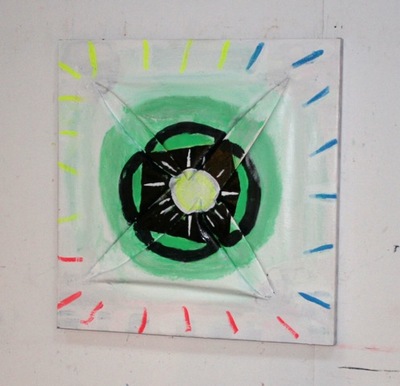A Studio Visit with Katherine Bradford
By Craig Stockwell
I am contemplating how to undertake a loss of control in the studio. I visited Katherine Bradford at her Harpswell, Maine studio on an August afternoon. In the barn, as it should be. It was raining and later we sat by a wood fire in the kitchen. Katherine Bradford’s work frightens me. It is such a brave and delicate world she is attempting. In this particular world of painting there’s not much there. The paintings are insubstantial, undernourished, even poorly painted. There is a conscious proclivity to refuse continuity. There is a fumbling about in the dark which runs the risk of that abstract expressionist existentialist bravado. But this painting is done with so little bravado and the expressionism is quiet and yearning. Without being histrionic, this painting believes in the possibility of emotional exchange.

Katherine Bradford’s studio
An interesting trajectory: In the ‘70s Katherine was a Maine back-to-the-lander with her husband and twin babies. She began painting then, abstract paintings. We talked about the amazing ability of twenty-somethings occasionally to zero in on the heart of current art making and come away with some focused insight into the possibilities that exist at their moment. Think of Frank Stella in the late ‘60s. So many others since. She says that she was an awful painter in her twenties and I note that only by persistance and desire has she attained a stuttering yet sublime voice. She left the husband and Maine and settled in Brooklyn (Williamsburg) at its early moments. She found her way into a community of artists, a community struggling for voice and conversation. She persisted.
At some point, out of the abstraction, images emerged. The images first appeared, for Katherine, when she saw what was coming to resemble water. Once there was water things appeared in the water: ships, swimmers. The important thing here is that the things emerged out of strokes of paint. She did not paint figures, daubs of paint came to resemble figures and then were developed into vaguely present figures. Always a vague ambiguity of image delivered with a full painterly vocabulary. Paint first. So, these images emerged.

Katherine Bradford, Super Flight, 2011
I continue to ask my interviewees: what are the edges that worry you, the places you might fall off? Katherine has been astonished by these figures and ships but they are also a worry. A friend suggested that they run dangerously close to New Yorker covers, the figures suggestive of an idea that is illustrated. I don’t see it that way although I understand the risk. In her show at Edward Thorpe Gallery in New York last spring, she developed wonderfully ambiguous images of Superman. This Superman was much in doubt, yet noble in the effort to simply be, to try to be heroic. This Superman is strangely thick-hipped and barely able to fly; yet fly he does. This hero is noble and true, yet lacks authority and power. Here is the sad heroic without the tragedy. The heroic is re-examined and re-presented.
When I arrived at Katherine’s studio she was willing to show me a new group of paintings she was engaged with. After a very succssful show in New York she came to Maine for a summer’s work with a group of eighteen found canvases. A friend had called and alerted her to a Brooklyn dumpster full of stretched and vaguely complete abstract paintings that had been discarded after each had been slashed with an X through the center of the canvas.
The first act became one of repair and return. They had been painted in acrylic which enabled an easy return to white gesso. The slashes were repaired in a casual way: tape, canvas and glue on the canvas back. I was struck by this lovely metaphorical act of repairing and retreiving discarded paintings. It is a beautiful act of displaced caring and it served to begin a new group of paintings with a curious history and even a burden of failed hope. It also required that the paintings be worked through with acrylic rather than Katherine’s familiar oil. It required a fresh and generous response, it required a response that was already based in a lack of control and authority.
This is the scary proposition that Katherine’s paintings make to me, this giving up of a certain kind of control. When I saw Katherine’s show at Thorpe Gallery it was in the context of an artist’s talk being given by Katherine. During the questioning the topic of women artists came up. I threw in the comment that I had recently (casually) noticed that if I were to currently name ten painters whose work I am interested in they happen all to be women (Charline von Heyl, Carrie Moyer, Katherine Bernhardt, Ann Pibal, Josephine Halvorson, Lesley Vance, Anoka Faroque, Michelle Grabner, Patricia Treib, R.H. Quaytman…although I’d also have to throw Chris Martin in there). What calls to me is that there is something both bright and sensually aware/painterly aware in the works of these painters.
I had a conversation with Chris Martin awhile ago in which I said to him something like, “It seems that you’re attempting the ecstatic, that you understand that the ecstatic is probaly not possible in our mediated existence but nonetheless you have determined to attempt it, at least to bring it out for a try.” He agreed, and I think that this is what is showing itself in Bradford’s paintings as well, an awkward attempt to have a conversation about things that aren’t quite possible.

